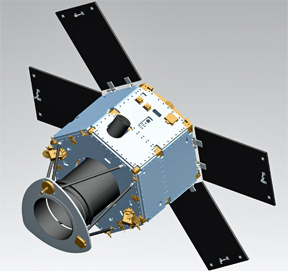
[SatNews] The Emirates Institution for Advanced Science and Technology (EIAST) shared the success of its DubaiSat-2 launch and the significance of its latest ambitious goal KhalifaSat at the 2014 Global Space & Technology Convention (GSTC), the latest edition of this yearly space meet.
Organized under the theme ‘Rise of the Rest,’ the three-day convention highlighted Asia’s critical role in the field of space technology. It also served as a venue for research organizations to showcase their latest space products and design concepts. Salem Al Marri, Assistant Director General for Scientific and Technical Affairs, EIAST, led the EIAST delegation that attended the international gathering organized by the Singapore Space & Technology Association (SSTA).

Artistic rendition of DubaiSat-2.
During the convention, EIAST reported developments after the successful launching of DubaiSat-2, its latest satellite, in orbit, and EIAST showcased the imagery taken so far by DubaiSat-2. The team also presented the plans for EIAST’s next mission KhalifaSat, which will be launched into outer space by 2017. Emirati experts and engineers are involved in the planning and designing of the KhalifaSat programme, which is expected to strengthen the standing of the Arab region in the competitive field of space science.
SSTA President Jonathan Hung delivered a speech formally welcoming delegates to the annual conference. Industry leaders and key decision makers then presented their reports on various space-related topics. The agenda of the first day included the specific needs of the Asia-Pacific, strategic government roadmaps, and mid-term requirements to boost the region’s growth over the next decade; the importance of forming partnerships within the thriving space industry; and the satellite communications requirements of airlines and oil and gas industries.
Participants also tackled the role of satellite communication systems in defense and security as well as in disaster and crisis management on the second day. Technical sessions followed after each report during the first two days, with delegates discussing new technologies that could contribute to expanding space-based solutions; satellite design and engineering; and the Asia-Pacific’s advanced capabilities and technical requirements for Synthetic Aperture Radar (SAR) systems application.
Salem Al Marri, Assistant Director General for Scientific and Technical Affairs, EIAST, said, “Participating in the GSTC 2014 was a great opportunity for us to show and share with the rest of the world the capabilities and expertise of the UAE in space science. EIAST has been making significant progress over the years in this field through our groundbreaking projects such as DubaiSat-1, DubaiSat-2, and now the KhalifaSat programme. Through our projects, we hope to further inspire scientific innovation and technological advancement and sustainable development not just in the Arab region but throughout the rest of the world as well.”
Held in Singapore in the first quarter of every year, GSTC aims to promote the rapidly developing space industry in Asia, which is now estimated to be worth over USD 258 billion. The growing demand for space-related services and new technology advancement and applications makes the conference even more significant.
EIAST was established by the Dubai Government in 2006 with the goal of promoting a culture of advanced scientific research and technology innovation in Dubai and the UAE, and enhancing technology innovation and scientific skills among UAE Nationals. It is mainly involved in outer space research and development; satellite manufacturing and systems development; space imaging; and ground station services and support for other satellites.
The EIAST infosite is located at http://www.eiast.ae/

